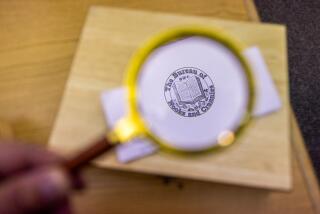‘Minders of Make-Believe: Idealists, Entrepreneurs, and the Shaping of American Children’s Literature’ by Leonard S. Marcus
Minders of Make-Believe
Idealists, Entrepreneurs, and the Shaping of American Children’s Literature
Leonard S. Marcus
Houghton Mifflin: 402 pp., $28
It seems a long way from the 1689 (or so) publication of the first American children’s book, which aimed to set young people “on the path to a good Christian life,” to today’s booming marketplace, rife with unabashedly commercial offerings that (in the eyes of the high-minded) lure kids away from more substantial fare. A cozy field once dominated by powerful librarians and dedicated female editors who luncheoned in “proper white gloves and smart little hats” is now ruled by marketing departments so confident of the power of branding that critics’ opinions are of no importance.
That’s the potted version of the history of American children’s book publishing, but Leonard S. Marcus’ lively, savvy work, “Minders of Make-Believe: Idealists, Entrepreneurs, and the Shaping of American Children’s Literature,” demonstrates that it’s by no means the whole story. Children’s books are “messages forged at the crossroads of commerce and culture,” he writes, and Americans have been parsing the relationship between the two since the early days of the republic.
Seeking “to make nursery books reasonable and truthful” -- unlike those lurid fairy tales that gave him nightmares as a child -- Samuel Griswold Goodrich in 1827 published the first of his books starring Peter Parley, designed to instruct and entertain in the manner pioneered by England’s John Newbery. These chatty tomes were such a success that Goodrich was soon hiring ghostwriters, setting up a system emulated by such 20th century entrepreneurs as Edward Stratemeyer (producer of the Hardy Boys, Nancy Drew, etc.).
“Peter Parleyism” came to be scorned as pedestrian; the children’s magazines launched after the Civil War published more imaginative fare: contemporary fairy tales by Hans Christian Andersen, as well as the rags-to-riches sagas of Horatio Alger and the highly colored adventure stories by “Oliver Optic.” These sensational tales earned the contempt of Louisa May Alcott, once a purveyor of pulp fiction herself but now the respectable author of “Little Women.” Alcott inaugurated an enduring strain of criticism with her scathing 1875 assessment of Oliver Optic and his ilk: Their work was formulaic and poorly written; their absurd plots gave young readers an unrealistic view of life.
Alcott’s views did not go unchallenged, notes Marcus, who quotes some persuasive rebuttals. He calmly notes that “not all children’s books are children’s literature” and refuses to beat up the purveyors of pure entertainment. As Marcus moves into the 20th century, his respect for the women who fought to establish children’s literature as a respected genre is evident. So is his amusement at their highhanded ways and their tendency to dismiss anything they didn’t like as “trash.”
First among these formidable doyennes was Anne Carroll Moore, who in 1906 became head of the New York Public Library’s Office of Work With Children. Next was Louise Seaman, who was named editorial director of Macmillan’s Department of Books for Boys and Girls, the first in the nation, in 1919. Other publishers followed suit in the 1920s, a decade of firsts in children’s books. In 1921, the American Library Assn., at the behest of Publishers Weekly editor Frederic G. Melcher, established the John Newbery Medal, the world’s first literary prize for a children’s book. The first issue of the Horn Book, the first critical review dedicated to children’s literature, appeared in 1924.
A “powerful new system for publishing and disseminating children’s books had taken shape,” writes Marcus, and much of its power rested with librarians. The imperious Moore held forth on what constituted a good children’s book in her New York Herald-Tribune pieces. The editors who followed Seaman into the new children’s departments of a half-dozen publishers in the ‘20s courted the approval of Moore and other librarians setting up children’s divisions; few bookstores would stock a title deemed unworthy of library adoption.
Well into the 1960s, the field was almost exclusively female. Seen as woman’s work, children’s books cracked open the men’s club of publishing to female membership. Marcus acknowledges the freedom their employers’ lack of interest gave these editors, while also pointing to the entrenched sexism that kept the heads of these profitable divisions from rising higher in the executive ranks. It was only in 1954 that editor Ursula Nordstrom, thanks to Harper’s commercial triumph with Laura Ingalls Wilder’s “Little House on the Prairie” series, became the first woman elected to the company’s board of directors. When a male colleague at a board meeting asked her to make the coffee, she tartly replied, “I’m sorry, but I don’t know how.”
Esteemed though Wilder’s books were, none won a Newbery Medal. The librarians who picked the winner were uneasy about giving an award for “literature” to a series; they felt the same about picture books, relegated to the runners-up category until Melcher proposed the Randolph Caldecott Medal for illustrated books in 1937. The librarians finally established a Laura Ingalls Wilder Medal for lifetime achievement in 1954 -- and gave its namesake the first medal.
Marcus’ shrewd assessment of children’s books’ evolution from the pioneering ‘20s through “ Harry Potter” duly notes many paradigmatic titles besides Wilder’s, including “The Little Engine That Could” and “The Polar Express.” His primary focus, however, is the people who produced those books and got them into children’s hands. American children’s-book editors and librarians took it as their mandate to make books widely available. The disagreements arose over what kinds of books those should be. Moore and her ilk favored “timeless tales” free of modern materialism. They were appalled by action-packed superhero comics, which outsold children’s books 10 to 1 in 1940, and dismayed by the launch that year of Little Golden Books, generic repackagings of classic stories between board covers, which cost only 25 cents and were sold (by the millions) in drugstores and the like. Editors who had devoted their lives to elevating the form with beautifully crafted books shared the librarians’ concern that mass-marketing was lowering the quality of children’s books. They couldn’t help noticing, however, that people who were intimidated by libraries and bookstores happily bought armloads of Little Golden Books at Woolworth’s. The debate went on through the rise of children’s paperbacks in the ‘60s and chain bookstores in the ‘80s, but the forces of the marketplace were unstoppable, especially after federal spending cuts dramatically lessened libraries’ purchasing power.
Children’s books have never been isolated from the rest of American culture, we see in Marcus’ nuanced and knowledgeable account. Vividly capturing the forceful personalities who shaped the genre, he chronicles their contributions in an engrossing narrative that shows the industry has stripped off those white gloves to become more diverse and democratic. *
Wendy Smith is a critic and the author of “Real Life Drama: The Group Theatre and America, 1931-1940.”
More to Read
Sign up for The Wild
We’ll help you find the best places to hike, bike and run, as well as the perfect silent spots for meditation and yoga.
You may occasionally receive promotional content from the Los Angeles Times.










